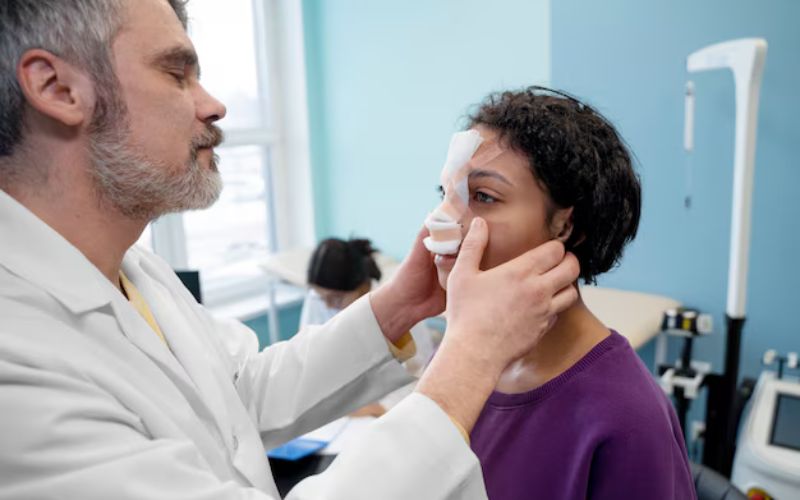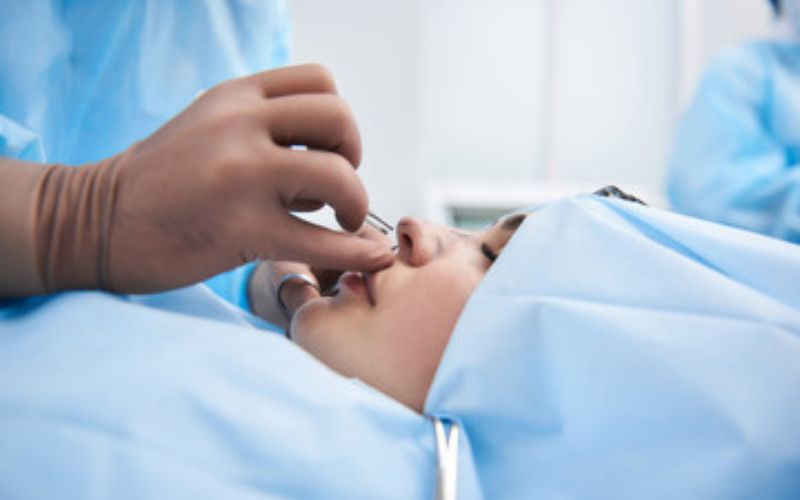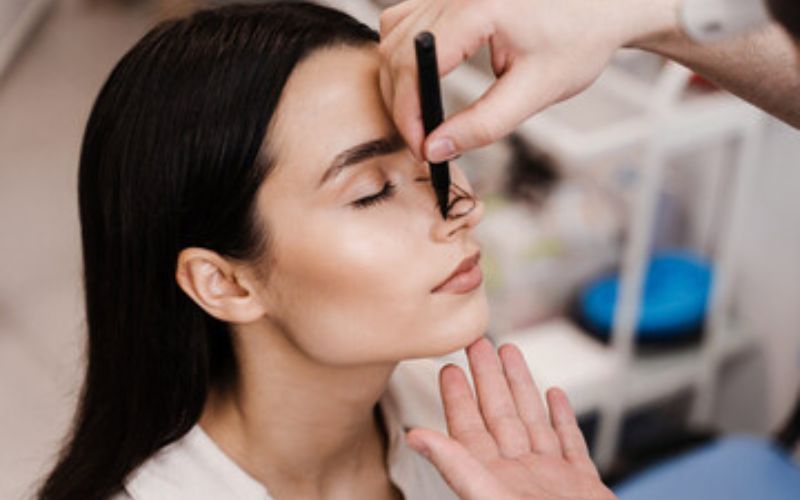Introduction
Rhinoplasty, commonly known as a nose job, is a popular surgical procedure aimed at enhancing the appearance and function of the nose. Whether you're considering nose plastic surgery for cosmetic reasons or nose reduction surgery for functional improvement, it's crucial to be well-informed about the process. At KJ Aesthetics, under the expert care of Dr. Vishal Brahmbhatt, patients can expect a comprehensive and personalized approach to Rhinoplasty. This blog will guide you through what to expect when going for a nose job, ensuring you are prepared and confident about your decision.
Understanding Rhinoplasty
Rhinoplasty is a surgical procedure designed to reshape the nose, either for aesthetic enhancement or functional correction. There are two main types of Rhinoplasty: cosmetic and functional. Cosmetic Rhinoplasty focuses on improving the appearance of the nose, addressing issues such as size, shape, and symmetry. Functional Rhinoplasty, on the other hand, aims to correct structural problems that impair breathing, such as a deviated septum.
Common reasons for undergoing Rhinoplasty include
Improving the overall appearance of the nose Correcting congenital defects or deformities Repairing damage from injury or trauma Enhancing breathing and nasal function
Initial Consultation
The initial consultation is a critical step in the Rhinoplasty journey. During this meeting, you will discuss your goals, medical history, and any concerns with Dr. Vishal Brahmbhatt. He will evaluate your nose's structure, skin quality, and overall facial features to determine if you are a good candidate for the procedure.
Key aspects of the initial consultation include Comprehensive evaluation of your nasal structure Discussion of your expectations and desired outcomes Review of your medical history and any previous nasal surgeries Explanation of the surgical options and techniques available
Preparation for the Surgery

Proper preparation is essential for a successful Rhinoplasty. Dr. Vishal Brahmbhatt will provide detailed pre-surgery guidelines to ensure you are ready for the procedure. This may include
Avoiding certain medications and supplements that can increase bleeding Quitting smoking to promote better healing Arranging for someone to drive you home after the surgery Medical evaluations and tests, such as blood work and imaging studies, may be required to assess your overall health and readiness for surgery. It's also important to have a clear understanding of the expected outcomes and to communicate openly with your surgeon about your goals.
The Rhinoplasty Procedure
Rhinoplasty can be performed using different techniques, depending on the specific needs of the patient. The two primary approaches are open Rhinoplasty and closed Rhinoplasty.
Open Rhinoplasty: Involves making an incision across the columella (the tissue between the nostrils) to allow better visualization and access to the nasal structures.
Closed Rhinoplasty: Involves making incisions within the nostrils, resulting in no visible external scars. The procedure typically lasts between 1.5 to 3 hours and is performed under general anesthesia. Dr. Vishal Brahmbhatt will carefully reshape the nasal bones and cartilage to achieve the desired outcome.
How Painful is Rhinoplasty?
Rhinoplasty, like any surgical procedure, involves some level of discomfort and pain, but it is generally well-managed with proper medical care. Here's what you can expect regarding pain and how it is typically handled:
During the Procedure
Anesthesia: Rhinoplasty is performed under general anesthesia or local anesthesia with sedation, ensuring that you do not feel any pain during the surgery itself. Your surgeon will discuss the best anesthesia option for you during your consultation.
Immediately After the Surgery
Initial Discomfort: After the anesthesia wears off, you may experience some discomfort, pressure, and a feeling of congestion due to swelling and the nasal packing or splints that may be placed inside your nose.
Pain Management: Your surgeon will prescribe pain medications to help manage any discomfort during the initial recovery period. Over-the-counter pain relievers like acetaminophen can also be effective.
One to Two Weeks After Surgery
Decreasing Pain: Most patients report that pain significantly decreases within the first week. By the end of the second week, discomfort is usually minimal and manageable with less frequent use of pain medications.
Removal of Packing and Splints: If nasal packing or splints were used, they are typically removed within a week, which can alleviate some of the pressure and discomfort. .
Is Rhinoplasty 100% Safe?
Rhinoplasty, like any surgical procedure, carries some inherent risks and potential complications. While it is considered a safe and routine surgery when performed by an experienced and qualified surgeon, it is important to understand that no surgical procedure is 100% risk-free. Here’s a comprehensive look at the safety of rhinoplasty:
Common Risks and Complications
Infection : Post-surgical infections are a risk with any surgical procedure. However, this risk is minimized with proper sterilization techniques, antibiotics, and careful post-operative care.
Bleeding : Some bleeding is expected after rhinoplasty, but excessive bleeding is a rare complication. Your surgeon will provide instructions on how to minimize this risk.
Adverse Reactions to Anesthesia
Anesthesia is generally safe, but there is always a small risk of adverse reactions. An experienced anesthesiolo
How Long Can Rhinoplasty Last?
Rhinoplasty is considered a permanent surgical procedure designed to reshape and refine the nose's structure. The longevity of rhinoplasty results can be influenced by several factors, but generally, the changes made to the nose during the surgery are permanent. Here’s an in-depth look at the durability and longevity of rhinoplasty:
Permanence of Results
Structural Changes : The structural changes made to the nose during rhinoplasty, such as reshaping the bone and cartilage, are intended to be permanent. Once these tissues are altered and healed, they typically maintain their new shape for a lifetime.
Aging Process : While the structural modifications are permanent, the aging process continues. Over time, natural aging can cause subtle changes in the skin and soft tissues of the nose. These changes are usually minor and do not significantly alter the results of the rhinoplasty.

Factors Influencing Longevity
Surgical Technique
The skill and technique of the surgeon play a crucial role in the durability of the results. An experienced surgeon like Dr. Vishal Brahmbhatt at KJ Aesthetics uses advanced techniques to ensure that the changes are stable and long-lasting. Whether you're undergoing nose plastic surgery for aesthetic reasons or nose reduction surgery for functional improvement, the quality of the surgical technique is vital.
Healing Process
Proper healing is essential for the long-term success of rhinoplasty. Following post-operative care instructions and attending follow-up appointments can help ensure that the nose heals correctly and maintains its new shape.
Skin Quality and Thickness
The quality and thickness of your skin can influence how well the nose maintains its new shape. Thicker skin may be less likely to show fine details of the reshaping, while thinner skin can reveal more definition but may be more prone to minor irregularities. Lifestyle Factors Factors such as smoking, sun exposure, and overall health can affect the longevity of rhinoplasty results. Maintaining a healthy lifestyle and protecting your skin from excessive sun exposure can help preserve the appearance of your nose after nose plastic surgery or nose reduction surgery.
Cost and Financing
Having realistic expectations is essential for satisfaction with your Rhinoplasty results. While the procedure can enhance the appearance and function of your nose, it's important to understand that perfection is not always achievable.
Reviewing before-and-after photos of previous patients can help set realistic expectations.Long-term outcomes of Rhinoplasty are generally very positive, with many patients reporting improved self-confidence and quality of life. Dr. Vishal Brahmbhatt's expertise and artistic approach ensure that each patient achieves a natural and harmonious result from their nose plastic surgery or nose reduction surgery.
Factors Influencing Longevity
Surgical Technique
The skill and technique of the surgeon play a crucial role in the durability of the results. An experienced surgeon like Dr. Vishal Brahmbhatt at KJ Aesthetics uses advanced techniques to ensure that the changes are stable and long-lasting. Whether you're undergoing nose plastic surgery for aesthetic reasons or nose reduction surgery for functional improvement, the quality of the surgical technique is vital.
Healing Process
Proper healing is essential for the long-term success of rhinoplasty. Following post-operative care instructions and attending follow-up appointments can help ensure that the nose heals correctly and maintains its new shape.
Skin Quality and Thickness
The quality and thickness of your skin can influence how well the nose maintains its new shape. Thicker skin may be less likely to show fine details of the reshaping, while thinner skin can reveal more definition but may be more prone to minor irregularities. Lifestyle Factors Factors such as smoking, sun exposure, and overall health can affect the longevity of rhinoplasty results. Maintaining a healthy lifestyle and protecting your skin from excessive sun exposure can help preserve the appearance of your nose after nose plastic surgery or nose reduction surgery.
Recovery Process
The recovery process is a crucial phase of Rhinoplasty. Immediately after the surgery, you will be monitored in a recovery area before being allowed to go home. You can expect some swelling, bruising, and discomfort, which can be managed with prescribed medications.
Key points to consider during recovery
Keeping your head elevated to reduce swelling Avoiding strenuous activities and heavy lifting
Following your surgeon's post-operative care instructions
Most patients can return to work and normal activities within 1-2 weeks, although complete healing may take several months.
Regular follow-up appointments with Dr. Vishal Brahmbhatt will ensure your recovery is progressing well. .
Frequently Asked Questions (FAQ)
Rhinoplasty, commonly known as a nose job, is a surgical procedure designed to reshape the nose for aesthetic or functional purposes. It can correct issues such as size, shape, and structural defects that impair breathing.
Conclusion
Rhinoplasty is a transformative procedure that can enhance both the appearance and function of the nose. By choosing an experienced and reputable surgeon like Dr. Vishal Brahmbhatt at KJ Aesthetics, you can expect personalized care and outstanding results. If you're considering nose plastic surgery or nose reduction surgery, schedule a consultation today to begin your journey towards a more confident you.

